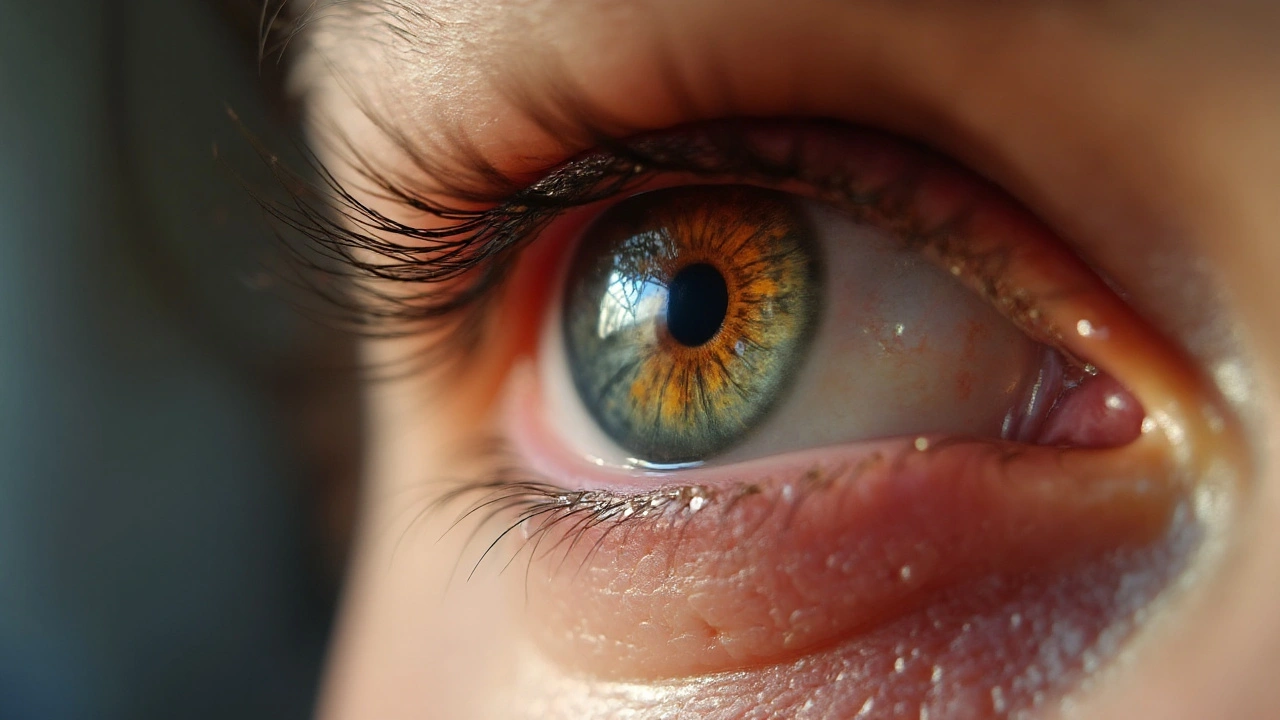Untreated bacterial eye infection is a medical condition where pathogenic bacteria invade the ocular surface and are left without appropriate antimicrobial therapy. Left unchecked, the infection can spread deeper into eye structures, setting off a cascade of inflammation, tissue destruction, and irreversible visual impairment.
Most readers land here because they need to know what can happen if they ignore red, painful eyes. The good news is that early treatment usually prevents serious outcomes, but once the infection runs its course, the damage can linger for years. Below you’ll find a practical guide that walks you through the biology, the long‑term risks, real‑world case snapshots, and what you can do now to protect your sight.
What Is an Untreated Bacterial Eye Infection?
Eye infections fall into several categories. The most common front‑line culprit is bacterial conjunctivitis, an inflammation of the conjunctiva caused by bacteria such as Staphylococcus aureus or Streptococcus pneumoniae. When the infection spreads beyond the conjunctiva, it can involve the cornea (keratitis), the inner eye (endophthalmitis), or even the retina.
Key players in the damage chain include the bacterial species themselves, the host’s immune response, and the eye’s delicate structures-cornea, lens, retina, and optic nerve. Each of these entities can be described by a set of attributes:
- Staphylococcus aureus: Gram‑positive, produces toxins, often linked to severe corneal ulceration.
- Pseudomonas aeruginosa: Gram‑negative, thrives in moist environments, notorious for rapid corneal melt.
- Corneal scarring: Opacification of the transparent cornea, measured by scar depth (microns) and impact on visual acuity.
How Common Bacterial Eye Infections Progress Without Treatment
Imagine a mild case of bacterial conjunctivitis that you shrug off as a nuisance. Within 48‑72hours, the bacterial load can double, releasing enzymes that degrade the corneal epithelium. If the cornea is breached, bacteria gain access to the stroma, where they trigger a robust inflammatory response. This is the turning point where temporary discomfort becomes a permanent threat.
Clinical data from the Royal College of Ophthalmologists (2023) show that roughly 12% of untreated conjunctivitis cases evolve into keratitis, and of those, 30% progress to corneal ulceration requiring surgical intervention. The timeline matters: the longer the infection sits, the higher the risk of stromal melt, neovascularisation, and ultimately, a scar that blocks light.
Another pathway involves the aqueous humor. When bacteria breach the anterior chamber, they can cause endophthalmitis, an intra‑ocular infection that spreads to the retina. This scenario is rare but devastating-studies report permanent vision loss in up to 70% of untreated cases.
Key Long-Term Ocular Complications
Below is a concise look at the major sequelae that clinicians refer to when assessing a patient’s history of untreated infection.
| Pathogen | Typical Severity | Risk of Corneal Scarring | Common Complication |
|---|---|---|---|
| Staphylococcus aureus | Moderate‑to‑Severe | High (40‑60% if untreated) | Corneal ulcer, vision loss |
| Pseudomonas aeruginosa | Severe, rapid progression | Very High (70‑90%) | Corneal melt, perforation |
| Streptococcus pneumoniae | Mild‑to‑Moderate | Low‑Medium (10‑25%) | Endophthalmitis if deep invasion |
Beyond scarring, several other entities emerge as long‑term consequences:
- Vision loss: Measured by a drop in Snellen acuity, often irreversible when scar depth exceeds 200µm.
- Ocular hypertension: Chronic inflammation can impede aqueous outflow, raising intra‑ocular pressure and increasing glaucoma risk.
- Cataract formation: Persistent inflammatory mediators accelerate lens opacity, especially in older adults.
- Retinal damage: In cases of endophthalmitis, bacterial toxins can scar the retinal pigment epithelium, leading to central vision defects.
These complications are not isolated; they often interact. For example, ocular hypertension can exacerbate optic nerve damage already weakened by retinal scarring, creating a feedback loop that worsens vision loss.
Case Studies Illustrating Permanent Damage
Case A - The Forgotten Conjunctivitis: A 34‑year‑old office worker ignored a week‑long red eye, attributing it to screen strain. Within two weeks, she developed a central corneal ulcer caused by Staphylococcus aureus. After a delayed presentation, the ulcer left a 250‑µm scar, reducing her best‑corrected visual acuity from 20/20 to 20/80.
Case B - Contact Lens‑Associated Pseudomonas Keratitis: A 22‑year‑old university student wore soft lenses overnight. A minor scrape introduced Pseudomonas aeruginosa. She missed the urgent care appointment, and the infection progressed to corneal melt within three days. Surgical graft was required, yet the graft failed after six months because of persistent inflammation, culminating in permanent light perception only.
Case C - Endophthalmitis After an Untreated Corneal Abrasion: A 58‑year‑old farmer sustained a rust‑ring injury. No antibiotics were applied, and a week later he experienced severe eye pain and blurred vision. Cultures identified Streptococcus pneumoniae. Despite aggressive intra‑vitreal antibiotics given later, the patient retained a dense central retinal scar and a visual field loss of 30degrees.
These narratives underscore how a simple delay-often just a few days-can pivot an infection from a treatable nuisance to a lifelong visual handicap.

Prevention and Early Intervention Strategies
Stopping the cascade starts with awareness. The following checklist helps anyone spot red‑flag signs that warrant professional care:
- Persistent redness or pain lasting more than 48hours.
- Discharge that is thick, yellow, or green.
- Blurred vision or photophobia (light sensitivity).
- History of contact‑lens wear, especially overnight.
- Recent eye trauma or exposure to contaminated water.
When any of these items appear, seek an eye‑care professional promptly. Empiric topical antibiotics-often a fluoroquinolone for broad coverage-can halt bacterial proliferation within 24hours. For high‑risk pathogens like Pseudomonas aeruginosa, fortified antibiotics (e.g., tobramycin) may be required. Early treatment not only clears the infection but also reduces inflammatory cytokines that cause scarring.
Beyond drugs, maintaining ocular surface health is vital. Regular lid hygiene, proper contact‑lens hygiene (rub‑and‑rinse, no overnight wear), and protective eyewear when working with soil or chemicals dramatically cut infection odds. For the elderly or immunocompromised, routine eye examinations can catch subclinical inflammation before it spirals.
Related Topics and Further Reading
Understanding the long‑term trajectory of untreated bacterial eye infections links to several broader and narrower subjects:
- Broader: General ocular microbiology, systemic effects of chronic inflammation.
- Narrower: Management of bacterial keratitis, corneal transplantation outcomes, novel anti‑biofilm therapies.
Readers interested in the cellular mechanisms of scarring may explore “fibroblast activation in corneal wound healing,” while those worried about antibiotic resistance can dive into “emerging topical agents against multidrug‑resistant ocular pathogens.” Each of these topics builds on the core idea that early, appropriate treatment saves vision.
Bottom Line
If you ever notice a red, painful eye that won’t improve, remember this: an untreated bacterial eye infection isn’t just an inconvenience-it can set off a chain reaction that ends in permanent vision loss, corneal scarring, and other serious ocular complications. Prompt diagnosis, targeted antibiotics, and good eye hygiene are the three pillars that keep your eyes healthy for the long haul.
Frequently Asked Questions
Can a mild pink eye turn into serious eye damage?
Yes. Even mild bacterial conjunctivitis can progress to keratitis or endophthalmitis if left untreated. The risk rises sharply after 48‑72hours of unchecked symptoms.
What are the most aggressive bacteria that cause eye infections?
Pseudomonas aeruginosa is the most aggressive, especially in contact‑lens wearers. Staphylococcus aureus follows closely, while Streptococcus pneumoniae is generally less severe but can still cause deep infections.
Does an eye infection increase the risk of glaucoma?
Chronic inflammation from an untreated infection can raise intra‑ocular pressure, which is a known risk factor for secondary glaucoma.
How quickly should I seek treatment for a red eye?
If symptoms persist beyond 48hours, involve loss of vision, or produce thick coloured discharge, see an eye‑care professional immediately.
Are over‑the‑counter eye drops effective against bacterial infections?
OTC lubricating drops can soothe irritation but do not contain antibiotics. Only prescription‑strength antimicrobial drops can eradicate bacterial pathogens.







Bruce Heintz
September 25, 2025 AT 03:39Hey folks, if you’ve got a red, painful eye don’t wait – grab those drops and get checked out ASAP 😊. The quicker you act the less chance of scarring and future glaucoma. Keep those lenses clean and remember a tiny infection can snowball into a permanent vision problem. Stay proactive, stay safe! 🌟
William Lawrence
September 25, 2025 AT 18:56yeah because everyone loves walking around with blurry vision for fun. who needs clear sight anyway? ignoring a bacterial invasion is totally a great life hack.
Dalton Hackett
September 26, 2025 AT 10:13Bacterial eye infections are more than a nuisance; they are a cascade of pathological events that can compromise ocular integrity.
When the conjunctival epithelium is breached the bacterial load can double within hours, releasing proteases that degrade the extracellular matrix.
These enzymes, especially those secreted by Pseudomonas aeruginosa, accelerate stromal melt and can lead to perforation if left unchecked.
The host immune response then floods the tissue with cytokines, which, while intended to clear the pathogen, also contribute to collateral damage.
This inflammatory milieu promotes fibroblast activation and excess collagen deposition, ultimately forming a corneal scar.
A scar deeper than two hundred microns typically results in a measurable drop in Snellen acuity, often from 20/20 to worse than 20/80.
Moreover, chronic inflammation impairs the trabecular meshwork, elevating intra‑ocular pressure and setting the stage for secondary glaucoma.
In the posterior segment, bacterial toxins can infiltrate the retina, causing pigment epithelium disruption and central visual field deficits.
Clinical studies from the Royaal College illustrate that roughly twelve percent of untreated conjunctivitis cases evolve into keratitis.
Of those keratitis cases, about thirty percent progress to ulceration requiring surgical intervention such as keratoplasty.
Endophthalmitis, though rarer, carries a seventy percent risk of permanent vision loss when treatment is delayed beyond the first 48 hours.
Contact‑lens wearers are particularly vulnerable because biofilm formation on lenses creates a reservoir for pathogens.
Hygiene lapses, such as overnight wear or failure to replace solution, dramatically increase the odds of infection.
Preventive strategies therefore include strict lens hygiene, regular lid cleaning, and prompt professional evaluation of any red eye lasting more than two days.
Empiric broad‑spectrum topical antibiotics, like fluoroquinolones, can reduce bacterial counts within twenty‑four hours and blunt the inflammatory response.
In summary, early detection and appropriate antimicrobial therapy are the cornerstones of preserving visual function and preventing long‑term sequelae.
Henry Clay
September 27, 2025 AT 01:29Honestly, if you think a splash of discharge is “just a little irritation,” you’re kidding yourself 😒. The data don’t lie – untreated infection equals irreversible damage. Stop procrastinating and get proper antibiotics now. 👊
Grace Shaw
September 27, 2025 AT 16:46It is imperative to emphasize that any ocular redness persisting beyond forty‑eight hours warrants immediate professional assessment. The potential for corneal scarring, ocular hypertension, and secondary glaucoma cannot be overstated. Adhering to evidence‑based treatment protocols remains the most effective preventive measure.
Veronica Rodriguez
September 28, 2025 AT 08:03For anyone unsure about the appropriate antibiotic, a licensed ophthalmologist can prescribe fluoroquinolones such as ciprofloxacin or moxifloxacin, which cover the majority of bacterial pathogens. Early initiation typically resolves symptoms within 24‑48 hours and minimizes inflammatory scarring 😊. Follow‑up visits ensure the infection is fully eradicated.
Holly Hayes
September 28, 2025 AT 23:19Honestly the whole “just wait it out” attitude is defnitely not how any sane person should handle ocular health. Srsly, you dont want to end up with a permanent scar.
Sean Powell
September 29, 2025 AT 14:36Friends, whether you’re a contact‑lens wearer or not, keep those eyes clean and respect the microbes – they’re not just villains, they’re part of a larger ecosystem. A simple daily lid wash can be a game‑changer for many cultures that value natural health practices.
richard king
September 30, 2025 AT 05:53In the theater of the eye, the unseen bacteria are the tragic playwrights, scripting a saga of light and shadow that unfolds in silence. To deny them their cue is to invite chaos upon the canvas of perception.
Isha Khullar
September 30, 2025 AT 21:09Ignoring a red eye is a silent invitation to permanent darkness.
Lila Tyas
October 1, 2025 AT 12:26Hey everyone! 🚀 If you feel that burning sensation or see a nasty yellow discharge, don’t wait – grab your phone and call an eye doctor right now. Quick action can save your sight and keep you doing all the things you love, from reading to hiking. You’ve got this!
Mark Szwarc
October 2, 2025 AT 03:43First, make sure you’re using the correct dosage of the prescribed drops – typically one drop six times daily for the first 48 hours. Second, avoid touching the tip of the bottle to your eye or any surface to prevent contamination. Finally, schedule a follow‑up appointment within a week to confirm that the infection has resolved.
BLAKE LUND
October 2, 2025 AT 18:59Across many traditions, the eye is seen as the window to the soul, so protecting it with proper hygiene and timely care is a universal value that transcends borders.
Matthew Shapiro
October 3, 2025 AT 10:16While aggressive antibiotics are essential for Pseudomonas infections, overuse can contribute to resistance; therefore, culture‑guided therapy remains the gold standard when feasible.
Julia Phillips
October 4, 2025 AT 01:33Imagine the heartbreak of watching your world dim because of a simple untreated infection – that’s why the medical community urges prompt attention, turning potential tragedy into a story of recovery.
Richa Punyani
October 4, 2025 AT 16:49Dear readers, please remember that eye health is not merely a personal concern but a collective responsibility; maintain rigorous hygiene and seek professional care without delay to safeguard your vision for generations to come.
Ria Ayu
October 5, 2025 AT 08:06In pondering the fleeting nature of sight, one realizes that the clarity we cherish is fragile, reminding us to cherish each glimpse with vigilant care.
maya steele
October 5, 2025 AT 23:23Clinicians recommend initiating broad‑spectrum topical therapy while awaiting culture results, especially in cases with high‑risk organisms such as Pseudomonas aeruginosa. This approach reduces bacterial load and mitigates stromal degradation.
Sharon Lax
October 6, 2025 AT 14:39The pathophysiology of untreated bacterial keratitis underscores a cascade of proteolytic enzymatic activity, inflammatory cytokine surge, and extracellular matrix remodeling, culminating in irreversible corneal opacification.
paulette pyla
October 7, 2025 AT 05:56Oh sure, let’s all just ignore the red eye and hope for the best – because who needs clear vision when you can collect scars as trophies?